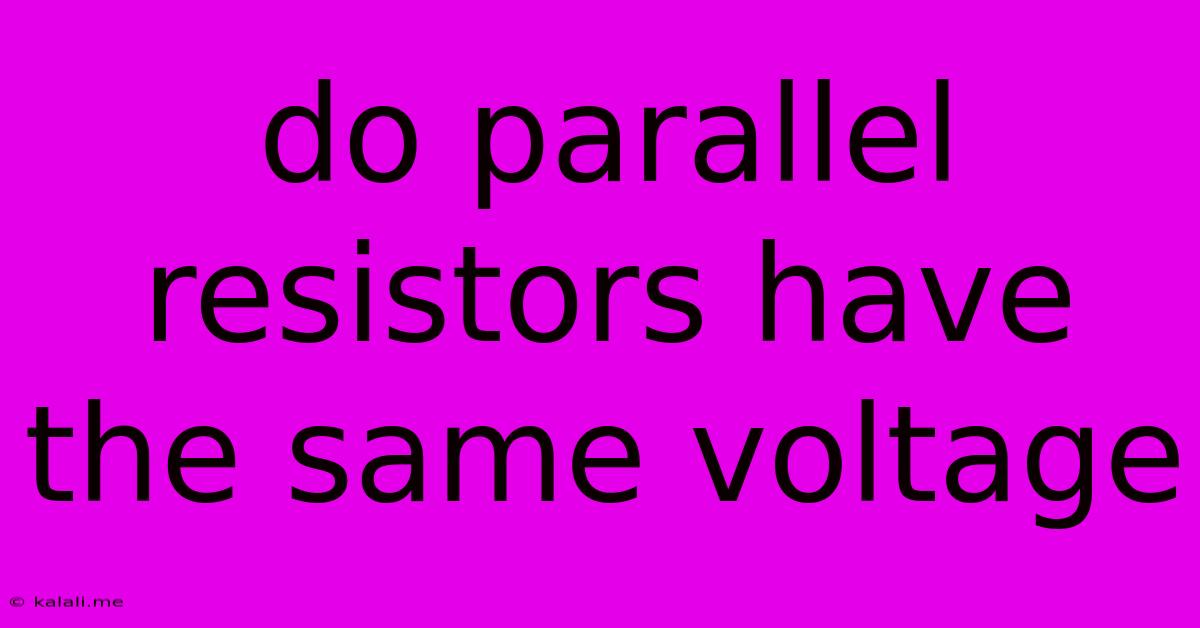Do Parallel Resistors Have The Same Voltage
Kalali
Jun 08, 2025 · 3 min read

Table of Contents
Do Parallel Resistors Have the Same Voltage? A Deep Dive into Circuit Analysis
Meta Description: Understanding parallel resistor circuits is crucial in electronics. This article explains why parallel resistors always share the same voltage, exploring the concept with examples and simple explanations. Learn about voltage dividers and Kirchhoff's Voltage Law for a complete understanding.
Parallel circuits are fundamental to electronics, and understanding their behavior is essential for any aspiring engineer or hobbyist. A common question that arises is: do parallel resistors have the same voltage? The simple answer is yes. Let's delve deeper into why this is true and explore the implications.
Why Parallel Resistors Share the Same Voltage
The key to understanding this lies in the very definition of a parallel circuit. In a parallel arrangement, each resistor is connected directly across the voltage source. Imagine a water pipe splitting into multiple parallel pipes; the water pressure (voltage) remains the same in each branch. Similarly, in an electrical parallel circuit, the voltage across each resistor is identical to the source voltage.
This is a direct consequence of Kirchhoff's Voltage Law (KVL). KVL states that the sum of voltages around any closed loop in a circuit must equal zero. In a simple parallel circuit with a voltage source and multiple resistors, tracing a loop through the source and any single resistor will show that the voltage drop across the resistor is equal and opposite to the source voltage.
Visualizing the Concept
Consider a simple circuit with a 12V battery and two resistors, R1 and R2, connected in parallel. The voltage across R1 will be 12V, and the voltage across R2 will also be 12V. It doesn't matter whether R1 is 10 ohms and R2 is 100 ohms; the voltage remains the same across both. The current, however, will differ depending on the resistance value (Ohm's Law: V=IR).
Contrast with Series Circuits
It's important to contrast this with series circuits. In a series circuit, the voltage is divided among the resistors. The voltage drop across each resistor depends on its resistance value relative to the total resistance. This is because the current is the same throughout the entire series circuit.
Implications and Applications
The fact that parallel resistors share the same voltage has significant implications for circuit design. This property is utilized in many applications, including:
- Voltage dividers: While not directly involving parallel resistors themselves, the principle is fundamental to understanding how voltage dividers work. A voltage divider uses a series arrangement to create different voltage levels from a single source, but understanding parallel resistor voltage is crucial when analyzing the load placed across a specific voltage tap.
- Current sharing: Parallel resistors provide a means of dividing current. This is crucial in applications requiring different current levels for various components, protecting sensitive circuitry from overcurrent.
- Redundancy and reliability: In critical systems, multiple parallel resistors (or other components) can increase reliability. If one fails, the others can continue functioning.
Calculating Equivalent Resistance
While the voltage is the same, the current through each resistor in a parallel circuit will be different. To simplify analysis, we calculate the equivalent resistance (Req). The formula for calculating the equivalent resistance of parallel resistors is:
1/Req = 1/R1 + 1/R2 + 1/R3 + ...
This allows us to treat the entire parallel combination as a single resistor for easier circuit calculations.
In conclusion, the consistent voltage across parallel resistors is a fundamental principle of circuit analysis, stemming from Kirchhoff's Voltage Law. Understanding this concept is critical for designing and analyzing various electronic circuits.
Latest Posts
Latest Posts
-
How Long To Read Fear And Trembling
Jun 09, 2025
-
1 Corinthians 14 Speaking In Tongues Alone
Jun 09, 2025
-
Can You Steep Tea In Milk
Jun 09, 2025
Related Post
Thank you for visiting our website which covers about Do Parallel Resistors Have The Same Voltage . We hope the information provided has been useful to you. Feel free to contact us if you have any questions or need further assistance. See you next time and don't miss to bookmark.